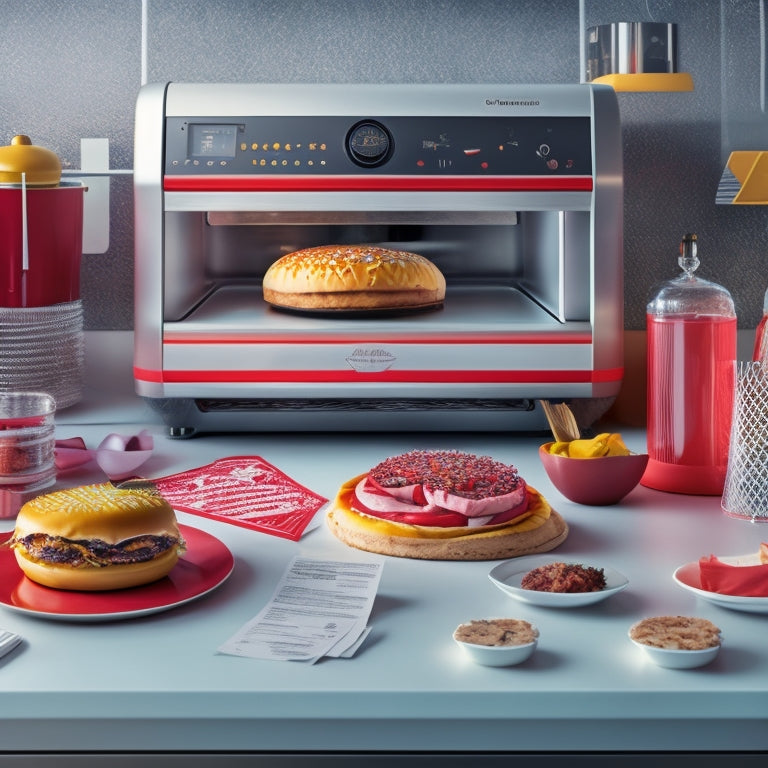
Risks and Tips for 3D Printing Food
Share
3D printing food poses a unique set of risks and challenges, including design flaws, material safety concerns, and bacterial contamination, which can compromise the quality and safety of the final product. To mitigate these risks, it's important to select food-grade materials, maintain proper washing and sanitizing, and prioritize bacteria prevention and chemical safety. Material selection matters, and certified food-safe materials are essential. By understanding these key factors, individuals can take proactive measures to guarantee the production of safe and healthy food products. Taking a closer look at these considerations can help uncover more specialized guidance for a successful and safe 3D food printing experience.
Key Takeaways
• Design flaws and material choices can create crevices for bacteria to thrive, emphasizing the importance of food-grade materials and safe design.
• Selecting food-grade materials and implementing washing and sanitizing protocols minimizes risks associated with 3D printing food.
• Obtaining food-grade certifications ensures material safety and performance, meeting specific requirements for safety and hygiene.
• Material selection matters, as it impacts safety and durability, and confirming compatibility with intended use is crucial.
• Implementing safe food handling practices, washing tools with warm water and antibacterial soap, and designing with food safety in mind guarantees safe food contact.
Food Safety Concerns Exposed
When delving into the realm of 3D printing food, it is important to recognize the potential food safety concerns that can arise from the intersection of technology and culinary arts. One important concern is bacteria prevention, as design flaws can create crevices where bacteria can thrive.
Additionally, the choice of filament can have a significant impact on chemical safety. Some filaments may release harmful chemicals into food, making it essential to choose food-grade materials. It is crucial to prioritize bacteria prevention and chemical safety to guarantee the production of safe and healthy food products.
Minimizing Risks in 3D Printing
While recognizing the potential risks associated with 3D printing food is vital, taking proactive measures to minimize these risks is equally important to ensure the production of safe and healthy food products. One pivotal step is ensuring filament safety by selecting food-grade materials that do not leach harmful chemicals into the printed food.
Additionally, washing precautions are essential to prevent bacterial buildup and contamination. Use warm water with antibacterial soap to clean the 3D printing equipment and tools. Regularly clean and sanitize the printing area to prevent cross-contamination.
Certified Food Safe Vs. Not
In contrast to general food safety guidelines, certified food safety involves meeting rigorous standards and regulations, ensuring that 3D printed kitchen tools and equipment are safe for use with food. This certification is crucial for manufacturers and consumers alike, as it guarantees that the products meet specific requirements for safety and hygiene.
| Certification | Description |
|---|---|
| Food Grade Certifications (e.g., NSF, UL) | Meet specific standards for material safety, durability, and performance |
| Regulatory Standards (e.g., FDA, EU) | Comply with government regulations for food contact materials |
| Third-Party Audits | Regular inspections to ensure ongoing compliance with certifications and standards |
Material Selection Matters
Careful selection of materials is vital in 3D printing kitchen tools. The type of material used can greatly impact the safety and durability of the final product. Material compatibility is an important consideration. Certain materials may react with food or harbor bacteria. Usage considerations also play a significant role. Materials may be suitable for occasional contact with food but not for prolonged exposure.
For instance, PLA may be suitable for cookie cutters, while ABS may be better suited for utensils. Confirming the chosen material is compatible with the intended use and food type is essential to prevent contamination and guarantee the safety of the end-user.
Safe Food Contact Guidelines
Selecting the right material is only half the battle, as the way 3D printed kitchen tools come into contact with food is equally important in securing food safety. To secure safe food contact, it's vital to follow specific guidelines.
- Obtain food grade certifications for your 3D printed kitchen tools to guarantee they meet food safety standards.
- Implement safe food handling practices, such as washing tools with warm water and antibacterial soap after each use.
- Make sure that all parts of the 3D printed tool, including the hot end and extruder, are designed with food safety in mind.
Frequently Asked Questions
Can I Use 3D Printed Kitchen Tools for Serving Raw Meat?
"As we venture into the uncharted territory of 3D printed kitchen tools, a pressing question arises: can we safely serve raw meat with these innovative tools? The answer lies in prioritizing food safety, carefully selecting materials, and exercising caution in usage to avoid cross-contamination."
Are There Any Food-Safe 3D Printing Services Available Online?
When seeking online options for food-safe 3D printing services, look for providers that explicitly guarantee food safety certifications, such as NSF International or FDA compliance, to verify your printed kitchen tools meet rigorous standards.
How Often Should I Replace My 3D Printed Kitchen Utensils?
'An ounce of prevention is worth a pound of cure.' Replace 3D printed kitchen utensils regularly, considering material durability and hygiene concerns, to maintain a safe and healthy cooking environment, ideally every 6-12 months or as needed.
Can I Paint or Coat My 3D Printed Kitchen Tools for Extra Safety?
When coating or painting 3D printed kitchen tools, consider food-safe coating options to minimize risks. Avoid using regular paints, as they may contain toxic chemicals, and instead opt for non-toxic, food-grade coatings specifically designed for kitchen utensils.
Are There Any 3D Printing Designs Specifically for Food Safety Certification?
As the pursuit of culinary innovation converges with 3D printing, an essential question arises: are designs tailored for food safety certification available? Indeed, creators can access food-grade materials and navigate the certification process to guarantee compliance and peace of mind.